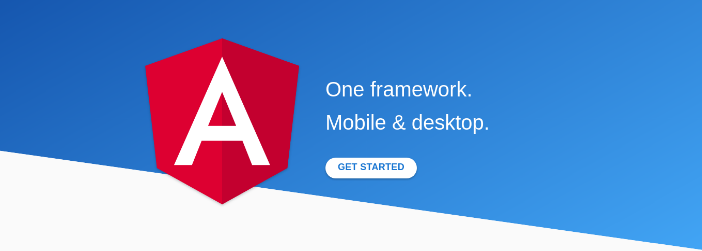Updated June 21, 2023

Introduction to Angular
AngularJS is an open-source web framework as a first version. Google backs AngularJS. AngularJS is the first front-end framework based on the MVC design pattern. This allows the feature called two-way binding, which enables it to reflect changes continuously on a page. Also, AngularJS provides features such as Dependency Injection, ready-to-use templates, and testing. It allows the development of Single Page Applications with neat and clean code. These features make AngularJS unique.
What is AngularJS?
Front-end technologies are evolved very much in the last 20 years. From very basic HTML, CSS, and JavaScript to many libraries and frameworks are available now with great functionality. Developers are now able to build very complex user interfaces in a very short amount of time. Since 2010 JavaScript frameworks have started to evolve, and at first, AngularJS entered the market. It became very famous in a short time. Eventually, as complications increased, a new version of Angular was written but incompatible with the old version. Due to this popularity of Angular started to decrease.
Angular v2 and above is a complete rewrite and a TypeScript-based framework. Angular features mobile support, whereas AngularJS does not. Angular is an improvement and has compatibility with newer versions.
List of Angular Alternatives
Below are the different Angular Alternatives which are as follows:
1. React
React is becoming one of the most popular frameworks nowadays. Some developers are switching from Angular to React. One of the engineers at Facebook created it. React is used in the development of Single-page as well as mobile applications. React provided innovative features such as Virtual DOM and one-way data flow.
React is declarative and has components based. This allows composing complex UI’s while cleanly maintaining code. React works in the View layer of the application. React is smaller and usually requires additional libraries while developing complex React Applications.
2. Vue
Another angular alternative is Vue. Vue.js is a progressive JavaScript framework created by author Evan You, which is now open source. Vue is powerful enough to build single-page applications. Vue has some similar concepts from both AngularJS and React. It works in the View layer of an application, has a virtual DOM feature, and supports additional libraries, similar to React. Vue has a template style similar to Angular, but performance-wise, Vue is more powerful because it is more lightweight.
Vue offers features such as Reactive Interfaces, CSS transitions & Animation, custom filters, and straightforward code. Vue is easy to understand and flexible.
3. Ember
Ember is an open-source JavaScript framework. It allows developers to build scalable single-page applications using best practices in a framework. Ember is based on Model-View-View-Model (MVVM) pattern.
Ember is being used by popular websites such as LinkedIn, Vine, Nordstrom, and many more. It is also possible to build desktop and mobile applications by using Ember. Apple Music is the most notable example of this.
Ember provides features such as Ember CLI, Ember templates, and the Ember Inspector tool used for debugging. Ember offers a friendly API that is easy to understand and work with.
4. Meteor
Meteor is a complete platform for developing web and mobile apps in pure JavaScript. It’s a free and open-source JavaScript framework that runs on the client and server. Meteor integrates directly with MongoDB and can propagate data changes to the client without any extra code. Meteor uses its template engine for design and can be utilized with Angular, React, and Vue frameworks.
Meteor is the best Angular Alternative as it is a full-stack framework; it is possible to build everything in an application by learning it once. Meteor is easy to learn and enables it to build faster, making it a favorite for developers.
5. Polymer
A polymer is an open-source JavaScript library for building web applications developed by Google developers. YouTube, Google Earth, Netflix, and Electronic Arts, among others, use Polymer.
A polymer is built on the concept of web components. Polymer offers features such as building custom HTML elements, cross-browser compatibility, and Polymer CLI. The polymer has some downsides, such as a lack of documentation and support, but being backed by Google, it has the potential to gain a significant market share.
6. Backbone
Developers use Backbone, a lightweight JavaScript library designed for developing single-page applications. It is based on the Model-View-Presenter (MVP) design pattern, which abstracts data into models, and DOM into views and binds these two using events. Backbone.js has been in the market for a long time and has a mature platform.
Backbone provides features such as a RESTful JSON interface, Syncing with the back-end, and Event-Driven communication. Backbone allows the building of web applications and mobile applications in an organized and well-structured format.
7. Aurelia
Aurelia is a next-gen modern open-source UI framework for developing web and mobile applications. It allows designing complex apps by using pure JavaScript or TypeScript. It follows the latest JavaScript standards. Aurelia is clean and has a nice API. Aurelia is concise and simple and at the same time, it is powerful and flexible. Aurelia is modular, it has a collection of libraries that can be used separately, and when combined, they form a powerful and robust framework.
Aurelia adopts the modern and reactive-based approach. It offers advantages and features such as Forward thinking, two-way data binding, Custom HTML elements, Testing, etc. Aurelia is developer friendly and easy to work with. Those interested in working on cutting-edge JavaScript applications will find Aurelia the best alternative to Angular.
8. Mithril
This is one of the most famous alternatives present for angular today. Mithril is a modern client-side JavaScript framework for building Single Page Applications. It’s small (< 8kb grip), fast, and provides routing and XHR utilities out of the box. Mithril is used by companies like Nike and Vimeo and open-source platforms like Liches.
It already has available documentation for common tasks. Mithril focuses on accomplishing meaningful work efficiently. Mithril is a complete platform for building web and mobile apps in pure JavaScript.
Recommended Articles
We hope that this EDUCBA information on “Angular Alternatives” was beneficial to you. You can view EDUCBA’s recommended articles for more information.










